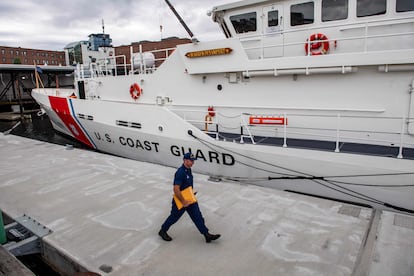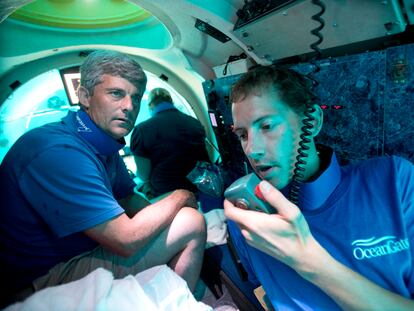Company behind missing Titanic submersible was warned in 2018 of ‘catastrophic’ safety risks
A Canadian military surveillance aircraft detected underwater noises early on Wednesday. Estimates suggest as little as a day’s worth of oxygen could be left if the vessel is still functioning

In 2018, OceanGate CEO Stockton Rush was warned by around 30 representatives of the submersible vehicle sector that “the current ‘experimental’ approach” of the company could result in problems ranging “from minor to catastrophic,” according to the newspaper The New York Times, which had access to the letter.
Rush is one of the five passengers on board the Titan, the submersible that went missing on Sunday during a dive to the Titanic wreckage. The submersible lost communication less than two hours after it began its dive to the wreckage, which is located at a depth of 4,000 meters in North Atlantic waters. It is not known whether OceanGate, which has organized several deep-sea dives and two to the Titanic, responded to the letter from the industry, which made no secret of its “unanimous concern” about the ship’s design and certification procedures, according to The New York Times.
The race is on to find the 6.5-meter submersible and its five passengers — Paul-Henry Nargeolet, a renowned Titanic expert; Hamish Harding, a world-record holding adventurer; Shahzada and Suleman Dawood, two members of one of Pakistan’s wealthiest families, and Rush. On Tuesday afternoon, Captain Jamie Frederick of the US Coast Guard said the submersible had 40 hours of “breathable air left.” This means that the air will run out at 6 a.m. on Thursday.
Canada and France are collaborating with the United States in the search. A Canadian military surveillance aircraft detected underwater noises early on Wednesday. A statement from the U.S. Coast Guard did not elaborate on what rescuers believed the noises could be, though it offered a glimmer of hope for those lost aboard the Titan as estimates suggest as little as a day’s worth of oxygen could be left if the vessel is still functioning.
Carl Schuster, a retired U.S. Navy captain, told The Wall Street Journal that many of the private submersible crews are ex-military officers trained in emergency response, including how to release a ballast to refloat the vessel. Under normal emergency protocols, the crew would attempt to communicate with boats on the surface and, failing that, would release a ballast until the sub surfaced. Experts believe there are four possible explanations for what happened: a fire, a blackout or a flood, or that the sub may have become entangled in something.
Schuster explained that some submersibles have a transmitting buoy. In an emergency, the crew would release the buoy to surface and signal rescuers. The former Navy captain added that the sonar used by the Coast Guard would not be able to detect the submarine if it is at the bottom of the ocean. If the submarine is unable to surface on its own, “getting anything out of that depth is a challenge” for rescue teams, who will likely need an unmanned underwater vehicle with highly-skilled operators, such as the one France has sent. The U.S. Army has a bathyscaphe for such an eventuality, but its range is significantly shorter than the depth at which the Titan would be.
OceanGate — which was founded by Rush in 2009 — is an example of the growing interest in extreme tourism. The Washington-based company owns three submersibles, including the Titan, which have completed more than 200 deep-sea dives, according to its website. OceanGate made two trips to the remains of the Titanic in 2021 and 2022. The company describes the dive to the Titanic as an extreme scientific excursion. The transatlantic liner sank in 1912 when it collided with an iceberg during its maiden voyage between Southampton and New York, More than 2,200 people were on board, 1,500 of whom drowned. It was one of the biggest transportation disasters of the 20th century. Its remains were located in 1985.
The U.S. Coast Guard reported that Polar Prince, the mother ship that towed the submersible from the port of Saint John in Newfoundland (Canada), some 434 miles (700 kilometers) away, to the dive area, lost contact with the Titan approximately one hour and 45 minutes after it began its descent. The U.S. Coast Guard — one of the branches of the armed forces — then sent two C-130 aircraft to the area, about 900 miles (1,450 kilometers) east of Cape Cod. A third C-130 joined the search on Tuesday. The Canadian Coast Guard has mobilized a plane and a ship, while France has provided Atalante, a vessel equipped with an underwater robot capable of deep exploration. The U.S. Navy could be mobilized if necessary, according to the White House National Security Council spokesman.
Rush, who had previous experience as an aviation pilot, was the commander of the Titan. In 2021, on the occasion of the sub’s first dive to the Titanic, he told the AP news agency that the trip was a scientific mission intended to document the slow deterioration of the wreck. “The ocean is taking this thing, and we need to document it before it all disappears or becomes unrecognizable,” he said. In another interview last year with the New York Times, the businessman stated that the high-resolution images obtained on guided tours of the Titanic could benefit researchers. He also defended the safety of the submersible, although, he stressed, nothing is without risk. “What I worry about most are things that will stop me from being able to get to the surface — overhangs, fish nets, entanglement hazard,” he told CBS News last year, adding that a good captain can avoid those dangers.
Sign up for our weekly newsletter to get more English-language news coverage from EL PAÍS USA Edition
Tu suscripción se está usando en otro dispositivo
¿Quieres añadir otro usuario a tu suscripción?
Si continúas leyendo en este dispositivo, no se podrá leer en el otro.
FlechaTu suscripción se está usando en otro dispositivo y solo puedes acceder a EL PAÍS desde un dispositivo a la vez.
Si quieres compartir tu cuenta, cambia tu suscripción a la modalidad Premium, así podrás añadir otro usuario. Cada uno accederá con su propia cuenta de email, lo que os permitirá personalizar vuestra experiencia en EL PAÍS.
¿Tienes una suscripción de empresa? Accede aquí para contratar más cuentas.
En el caso de no saber quién está usando tu cuenta, te recomendamos cambiar tu contraseña aquí.
Si decides continuar compartiendo tu cuenta, este mensaje se mostrará en tu dispositivo y en el de la otra persona que está usando tu cuenta de forma indefinida, afectando a tu experiencia de lectura. Puedes consultar aquí los términos y condiciones de la suscripción digital.
More information
Últimas noticias
Maduro pleads not guilty before the federal court in New York: ‘I am still the president of Venezuela’
A new test can detect Alzheimer’s from a finger prick
UN team enters Sudanese city of El Fasher after paramilitary massacre: ‘It’s like a ghost town’
A recipe for resistance: Indigenous peoples politicize their struggles from the kitchen
Most viewed
- Gilles Lipovetsky: ‘If you want to live better and fall in love, take Prozac, don’t look to philosophy’
- Alain Aspect, Nobel laureate in physics: ‘Einstein was so smart that he would have had to recognize quantum entanglement’
- Alvin Hellerstein, a 92-year-old judge appointed by Bill Clinton, to preside over Maduro’s trial in New York
- Why oil has been at the center of Venezuela-US conflicts for decades
- Maduro’s downfall puts China’s relationship with Venezuela to the test










































